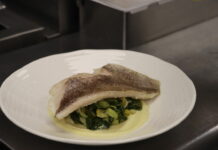
There’s a familiar, nostalgic quality to the scene: a dozen or so gentlemen in evening dress, sitting around a table laden with fine wines and superb food, chatting with apparent insight, wit and sophistication. It could almost be a tableau vivant from H.L. Mencken’s “Heathen Days” memoir, but it is, instead, a March dinner of Baltimore’s Cork and Fork Society, an unabashedly for-men-only club whose members – my good self included – are dedicated to the proposition that if you want to eat well, learn to cook it yourself.
Cork and Fork is in its sixth year of pursuing not only good cooking, but also fine wine and conversation. We meet every six weeks or so for a dinner designed by the member who serves as that evening’s master chef. The black-tie trappings are mostly superficial. What matters here is not our social connections but your skill with a sauté pan and the size of your wine cellar. In fact, my fellow members are, to a man, refreshingly irreverent about their club. Thus, a Cork and Fork dinner is less Henry Higgins, more Bertie Wooster; sort of a combination middle-aged guys’ fraternity, cooking seminar, and wine-and-travel club.
Tonight’s master chef is a new member – Baltimore architect Jens Mammen, a one-time San Francisco caterer who takes his responsibilities very seriously indeed. Hours prior to the first guest’s arrival, Mammen and his crew of “sous-chefs” (BSO violinist Nelson Stewart and Elk Run Vineyards owner Fred Wilson) are in their shirt sleeves, slaving away in the kitchen of the discreet uptown club that accommodates the group.
“I’m approaching this with a devil-may-care attitude,” announces Mammen. “I’m not going to get too worked up. I have been cooking since Saturday morning, though – you have to do that, because ‘last minute’ sucks.”
Sous-chef Stuart pokes admiringly at a 20-pound pile of raw tenderloin of elk, a protein source procured through a brother-in-law five states away after a venison supplier failed to come through. “This is bound to be the best meal ever cooked by the Cork and Fork,” he brays, “well prepared and perfectly presented.” And with that he stuffs an unlit cigar back into the corner of his mouth.
Master chef Mammen, who was born in Germany, has laid out a menu that revisits his past. A week before the event, I visited him in his Bolton Hill apartment for a preview. “The flavors will be earth,” he explains, starting with a three-onion tart he vividly remembers from childhood. “I’d really like to serve it with a red-pepper vodka. That’s how we used to do it.” Mammen seems unaware of an informal boycott of hard liquor. “Of course, there may be a decent wine that Fred Wilson will find,” I suggest, steering him back to the tradition. He blinks innocently.
Next up is a double shellfish consommé Mammen will make from scratch. “This starts us on an earth-fish-meat-fruit progression,” he says. “I hope it will have the taste of the sea, because that’s something I remember.” The twice-cooked stock, based on shellfish, fish bones and mirepoix (the classic mix of finely chopped carrot, onion and celery that enhances many a stock), will be clarified with egg-white and garnished with a jumbo shrimp.
Undeterred by the prospect of preparing his own stocks, Mammen will carry on with another demanding dish, roast quail served on a bed of risotto, sprinkled with wild mushrooms.
As for the quail, Mammen has been scrambling. “I discovered there aren’t many quail to be had, so I’ve been on the phone. Dean & Delucca [in Georgetown] have 22, and I think they may be the last quail in the entire area.” Next comes a salad of lentils and radish, a true throwback of his German roots.
The main meat course is slated to be venison tenderloin served with a pomegranate sauce, accompanied by winter vegetables. “I’ll probably make a sauce out of pan drippings and pomegranates, maybe some red wine,” he says, working out combinations of flavor and color. “I grew up with pork roast stuffed with apple and prune, and the most amazing fruits with meat. Of course if I can’t get the venison…” he muses prophetically.
The finale: “There’s usually a lot of wine on the table by the end of dinner, so we’ll go with cheese and some good crackers.”
The Cork and Fork Society was the brainchild of Paul Regester, currently the East Coast vice president of Napa’s Franciscan Vineyards. In 1989, inspired by an all women’s group called “Women in Wine” which customarily dined in restaurants, Regester assembled a small group of male friends to go the ladies one better, with the gentlemen doing the cooking. Members were originally drawn from the wine and restaurant trades. Inevitably, turnover occurred, but a strong contingent of talented cooks from Federal Hill brought fresh reserves to the club in the early ‘90s. Today the roster hovers around 20. Membership is by invitation only, and either keen familiarity with wine or proficiency in the kitchen are givens.
The Cork and Fork draws on two separate local traditions of dining. One is that Marylanders have never placed stringent gender restrictions on the kitchen; men as well as women have felt free to get in touch with their “inner chef.” There is also the matter of place: Baltimoreans have always cooked well. It is even said that the best cooking you are likely to encounter here will be not in the restaurants, but in private homes.
Charles Dickens, no scourge of the table, was bowled over by the culinary prowess of Baltimore, making it one of his favorite stops on his 1842 tour. A century later, foreign observers felt that most of America’s finest contributions to world cooking came from the Chesapeake tradition: canvasback duck, the crab cake, terrapin soup and corn on the cob. Eating clubs similar to the Cork and Fork have flourished in Maryland for centuries, many of them celebrating the venerable canon of “Maryland cuisine.” The Ancient South River Club has been meeting continually in Anne Arundel County since 1740. And colonial Annapolis was the seat of The Tuesday Club, whose charter of being “serious about not being serious” sounds closely reminiscent of the Cork and Fork.
The members in their suits and tuxedos begin filtering into the modestly appointed town house around 6:30 on a chilly Monday night. They climb a flight of stairs to a second-story living room, where platters of appetizers await. Jens Mammens’ pepper vodka is nowhere to be seen, but Fred Wilson’s sauvignon blanc is very much in evidence. Each new arrival is greeted warmly by the rest, as slices of hot onion tart are juggled to free up a hand.
Wilbur Norman, the revered “Pharaoh” of the society (the title was chosen for its echoes of Jackie Gleason and Fred Flintstone), quietly counts heads and consults with Betty Wright, the club’s official denmother. A retired veteran of the White House’s household staff, Wright is the only woman permitted at the Cork and Fork’s dinners. With the help of a nephew, she oversees the appointments of the dinner and supervises the table service, which is provided by club members, themselves.
Down in the kitchen, Mammen and Co. are wiping perspiration from their brows, fussing with the double consommé, which does in fact smell of the seaside. The Pharaoh pops his head in, Mammen nods, and in moments the order “Gentlemen, please be seated,” is given.
Jackets come off and the serious business of dining begins. The soup is wonderful, the enormous shrimp “floater” succulent, the consommé a rich broth that leaves the lips coated. The Elk Run Liberty Tavern chardonnay is perfect. It matches the consommé in richness and body, while its bright mineral notes find an echo in the slightly briny tang of the broth.
“Pharaoh” Norman, a rare-book dealer, makes a few opening comments and handles club business before informing the club of an upcoming auction of rare wines. He cites an 1868 Madeira that will go on the block and solicits comments.
“Madeira’s all right,” drawls physician Peter Kaplan, “but we should be looking at Ports. And of course we don’t want to go above the 1920s, although the ‘55 was a damned good vintage.” It’s pure self satire, and the other gents hoot their derision.
As the quail on risotto arrives, Wilson uncorks several bottles of his own cabernet sauvignon. The conversation bounces from tangent to tangent, staying for the most part out of the gutter. Alan Bennett’s play “The Madness of George III” comes up, apropos of nothing. This leads to talk of interfering lawyers, and broadsides aimed at the several attorneys present. There’s chat about the language of kings, and the corruption thereof, which gives way to faulty attempts to enumerate the kings of England. From there, it’s half a skip to Shakespeare and the theater, and so the circle closes. A pause.
“Have I ever told you what raw Chianti tastes like?” Nelson Stewart queries to no one in particular. A general response of mild interest is enough to elicit a five-minute recitative on his recent trip to Italy, which is inelegantly interrupted by Dr. Kaplan’s assessment of an ‘81 La Mission Haut Brion that is making the rounds. “That’s classic! You don’t get that latakia taste everywhere, you know,” he says, referring to the trace of tobacco in this celebrated Bordeaux. He’s dead on, and I now wonder how much self satire still colors his comments.
While the conversation rambles on, few members are failing to tuck into Mammen’s quail and risotto. The rice is creamy dense perfection, tied back to the quail by the potent tarragon that flavors both. The Elk Run cabernet sauvignon is a light, spicy, vibrant wine. Even better, at four times the price, is the ‘81 “La Miss.” Its mere presence on the table speaks well of the generosity of the members. One of the group’s most cherished precepts is that great wine loves a great audience, and any bottle shared by the Cork and Fork has met a glorious end.
The salad arrives and is coolly refreshing. In the kitchen, Mammen is nearing dinner’s climax with his roasted elk. Six poignantly out of season pomegranates lay on the kitchen table, opened like small casks of rubies. Mammen seizes one and sprinkles the berries over plates of elk with winter vegetables. It’s a handsome presentation.
The main course occasions applause, and Mammen rises to accept it. More bottles of rare vintages are opened, and the room hums with conversation. I latch onto a bottle of 1990 Robert Mondavi unfiltered cabernet sauvignon; for me it is the wine of the night. Its deep rich concentration stands up firmly against the fruity pomegranate sauce in a spectacular way.
Dinner plates are swept away and platter of delicious cheeses appears. Members eye nearly empty bottles with thoughts of redeeming any missed sampling opportunities. A particularly redolent gorgonzola elicits enthusiastic cheers of “stinky cheese!” from the Federal Hill boys, who take a firm stand against reticence in their cheeses. Several members step outside for an after-dinner cigar. As a bottle of tawny port comes up from the cellar, another successful Cork and Fork dinner comes to a comfortable close. We have dined well, again.



